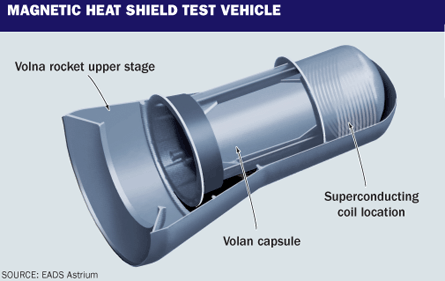European researchers developing a magnetic heat shield that could augment or replace the traditional ablative materials hope to make a test flight in the next decade.
Under development by EADS Astrium, with support from German aerospace centre DLR and the European Space Agency, the magnetic field-protected vehicle will be launched from a submarine on a suborbital trajectory to land in the Russian Kamchatka region.
As a capsule re-enters the atmosphere the air heats up around it due to friction and usually a high-temperature-resistant material is needed to absorb that. A magnetic field is able to deflect the hot atmospheric air away from the vehicle's surface, reducing or eliminating the need for a heat-absorbing material.
A super-conducting coil will generate the magnetic field that would extend out beyond the leading edge of the vehicle. Assessment of the coil is ongoing.
 |
|---|
"We are gaining more momentum. The DLR is on board. The plan is [to launch] three years after [approval]," Astrim's Detlev Konigorski, said at the European air and space conference 2009 in Manchester in October.
The flight test would use a Russian Volna rocket, which is able to launch a 650kg (1,430lb) payload. The Volan capsule will be the payload for the flight test. It will re-enter the atmosphere at up to Mach 21, and design work is under way to fit the super conducting coil system within its internal volume.
Other issues to be tackled include the ability of the coil to withstand the launch and flight environment; trajectory modification to compensate for the increased drag caused by the atmospheric gas deflection; and telemetry data recovery, when radio signal blocking ionised gases form around the vehicle.
Source: Flight International


























